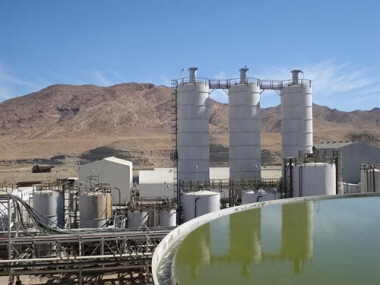Records tumble for uranium producers
17 January 2012
Correction - an earlier version of this article transposed Uranium One's attributable production figures for Honeymoon and Willow Creek. This has now been corrected. WNN apologises for any inconvenience caused.
Last year was a bumper year for Paladin Energy and Uranium One's uranium mines, while production at Denison and Rio Tinto's operations were victims of circumstance.
 |
| Paladin's Langer Heinrich had a good year (Image: Paladin) |
Paladin Energy and Uranium One have both released year-end figures celebrating the achievements of their operations in Africa, Kazakhstan, Australia and the USA.
For Uranium One, the year's attributable production totalled a record 10.7 million pounds U3O8 (4116 tU), up 45% on 2010 figures, with record full-year sales of 9.9 million pounds U3O8 (3808 tU) up 43% on the previous year. The majority of Uranium One's production comes from its Kazakh ventures, although 2011 also saw the company's first report of output from the Honeymoon in situ leach (ISL) operation in Australia, contributing 50,000 pounds U3O8 (19 tU) to the total.
The company's year-end figures also include output from the Willow Creek project in Wyoming for the first time, with output of 210,000 pounds U3O8 (81 tU) reported for the year. The Willow Creek project includes the Irigaray ISL central processing plant and the Christensen Ranch satellite ISL facility, and associated uranium ore bodies located in the Powder River Basin of Wyoming which it purchased from Areva in 2010. The company also confirmed that it is extending its option to acquire Mantra Resources from its own majority shareholder AtomRedMetzoloto (ARMZ) for a further year to June 2013.
The final quarter of 2011 saw both of Paladin's African uranium mines achieve "major step-changing breakthroughs", according to the company. The Langer Heinrich mine in Namibia achieved quarterly production of 1.193 million pounds U3O8 (459 tU). Two months of record production at 93% of nameplate capacity at the Kayelekera mine in Malawi more than offset the loss of 12 days of production in October when the acid plant was offline, resulting in record quarterly production of 632,000 pounds U3O8 (243 tU).
Toronto-based Denison's final 2011 production figures of 1 million pounds U3O8 (385 tU) from its White Mesa mill in Utah were lower than the company had expected because of difficult operating conditions with ore from the Daneros mine. The company said it expects to recover the shortfall in 2012, when it anticipates production from the mill to rise to 1.4 million pounds U3O8 (589 tU) from its US operations. "The 2012 plan is focused on increasing uranium production, reducing operating costs and growing our resource base through exploration, in particular in the Athabasca Basin in Canada on the Wheeler River project and in Zambia on the 100% owned Mutanga project" said Denison president and CEO Ron Hochstein.
Severe weather conditions in Australia during the first half of 2011 affected Rio Tinto's uranium production for the year, with its portion of production at Energy Resources of Australia's Ranger mine down 35% on the previous year at 3.81 million pounds U3O8 (1466 tU). The end of the year also saw Rossing's performance reduced by to lower grades as well as lower rates of milling and extraction. Coupled with a two-week maintenance shutdown during the final quarter, these factors brought Rio Tinto's portion of production from the Namibian mine output to 3.25 million pounds U3O8 (1250 tU) for the year, 41% down on 2010.
Researched and written
by World Nuclear News